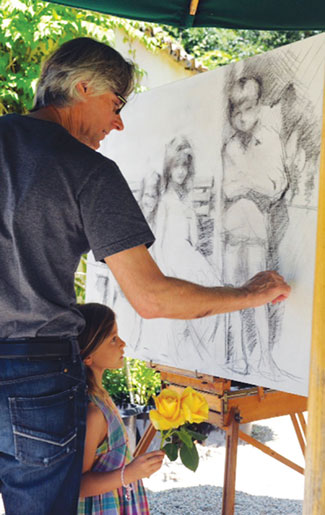
John Robert Peck always drew. Ever since he was a young boy, he would draw the things he saw, but instead of pursuing art, he went into a career in science, studying physics and doing research projects for NASA. Eventually his love of art and science catapulted him into a career in architecture. Still, there was a void.
“Back in 1997, I began studying painting for real,” said Peck, an instructor at the Triton Museum of Art. “I had never picked up a brush. I had drawn all my life, but I thought real artists [paint] and it’s time to get serious about this. So I began apprenticing with a guy in San Francisco, Bob Gerbracht, and for years I would go up and spend two nights a week studying with him – trying to learn to paint better. But I knew that I needed to go to school to really get serious about that, and, if I can humbly say, the bravest thing I ever did was I began looking around for schools where I could learn art formally. I found that all the programs were in Europe. So, I packed up my bags in 2001 and I moved to Italy.”
A graduate of the Florence Academy of Art, Peck paints in the classical portrait style and uses natural light in his paintings. The first step in his process is to have his subject pose while he completes a drawing. He then transfers that drawing to a canvas to use as an outline. Meanwhile, a second, smaller drawing is created and a color study is done to ensure the pigments are perfect. Finally, Peck paints the piece.

“My goal,” said Peck, “is to be as faithful as possible to what I see…I start with the charcoal drawing and when that’s satisfactory I transfer it onto canvas…and then you begin painting on top of it. It’s a very happy experience. It’s freeing, inasmuch as the labor of doing the drawing happens first. Then you can focus on color, shadow, values, and not have to worry about constantly correcting the drawing. You know that the person will keep their expression, their gesture and if it’s a client…you know the client will be pleased because they’ve already seen the drawing.”
When not creating paintings for clients, Peck teaches classical portrait oil painting, drawing and still life classes.
“I enjoy teaching drawing,” said Peck, “because I do know that when people want to make representational paintings of anything – of a landscape or a client, a person – it hinges on the drawing being good… On my website I have a little motto or statement or believe that I affirm and I’ve had this for 20-something years and I still think it’s true. ‘If you seek the miraculous, look to the ordinary but look very carefully.’ I feel like that is so connected to the art form of classical drawing and painting; because we want to look really carefully to discern what’s important and what’s not and only put in the important stuff.”
Peck will teach a two-day classical still-life workshop at the Triton on Saturday and Sunday, Nov. 23-24 from 10 a.m. to 4 p.m. Visit www.tritonmuseum.org/education_adults_workshops_Fall2013.php for more information. Visit www.johnpeck.com to learn more about the artist.





